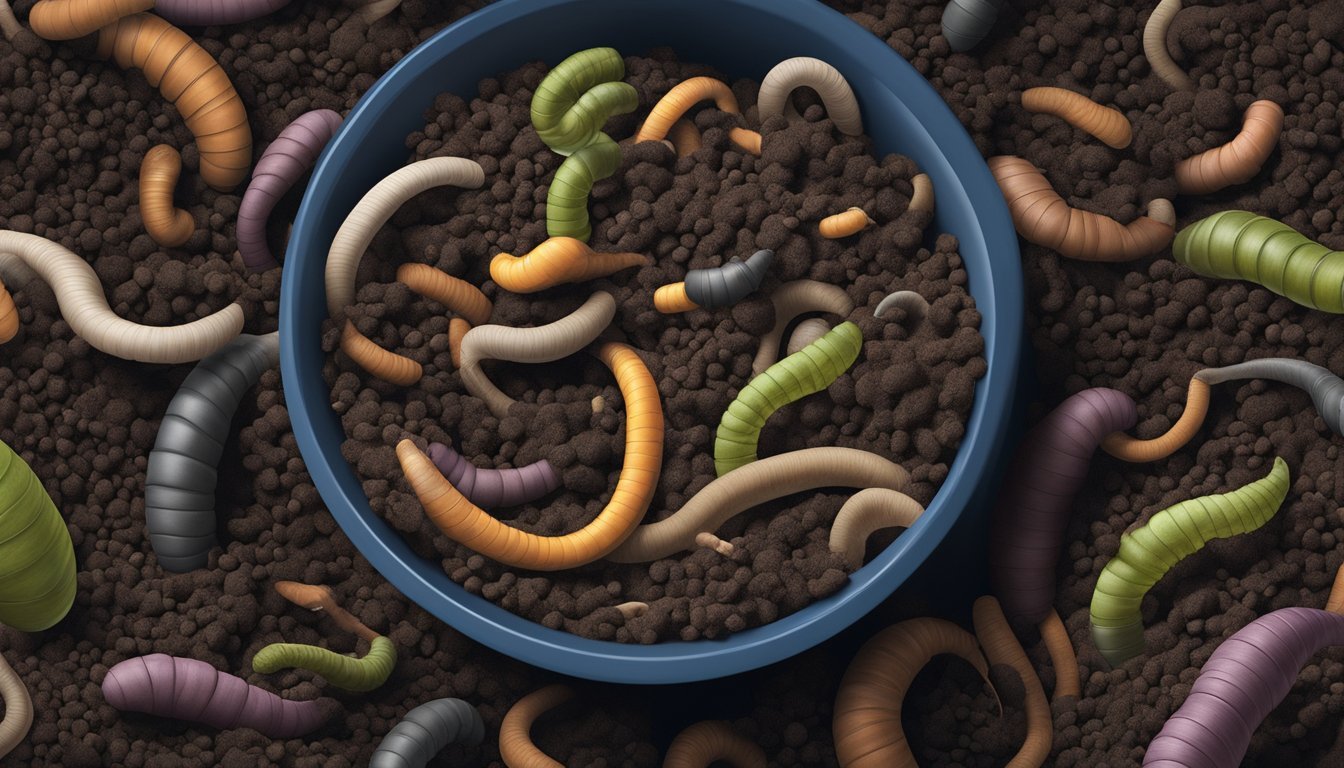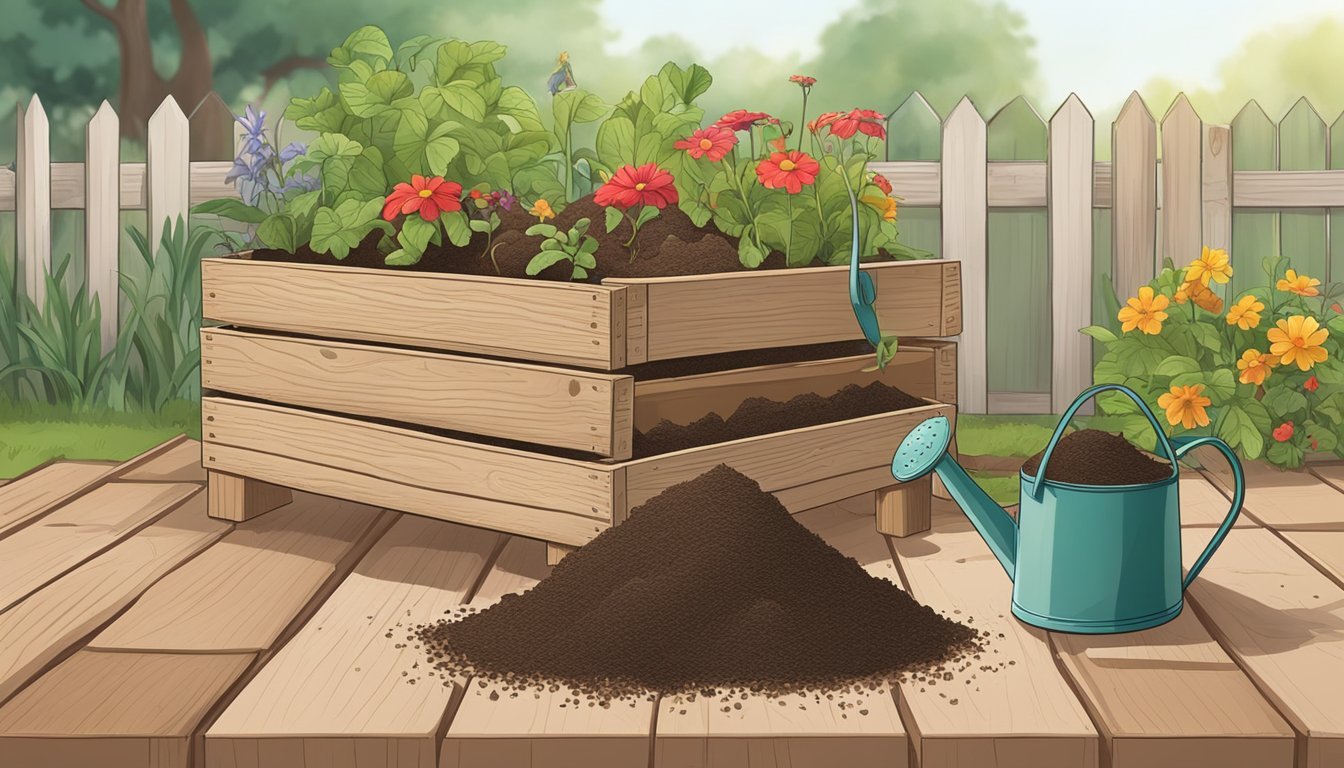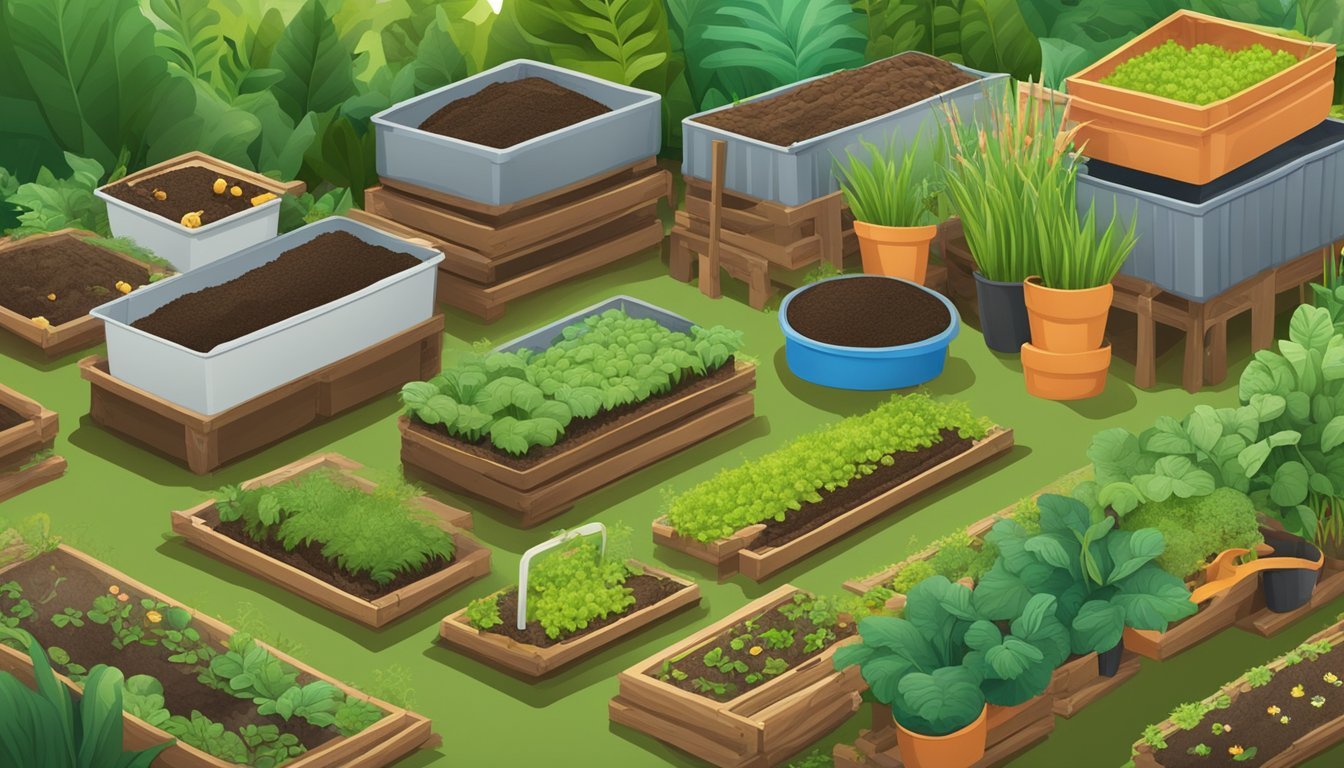Worm Farming for Soil Enrichment
Boosting Garden Health Sustainably
Worm farming, or vermicomposting, is a sustainable method of converting organic waste into nutrient-rich fertilizer that can significantly enrich garden soil. The heart of this process involves cultivating a specific species of worms, commonly red wigglers (Eisenia fetida), which possess an impressive ability to break down decomposing organic material. As these worms consume food scraps and other organic matter, they produce castings — a type of natural compost that is excellent for amending soil.
The advantages of this eco-friendly approach extend beyond creating a valuable soil additive. By diverting kitchen scraps and yard waste from landfills, worm farming reduces methane emissions and contributes to a smaller carbon footprint. The worm castings produced are packed with essential nutrients for plants, including nitrogen, phosphorus, and potassium, making them a superb, all-natural supplement for soil enrichment.
Through the maintenance of a simple worm bin system, gardeners and environmentally conscious individuals can continuously process their organic waste. This practice not only helps in creating a more fertile ground for planting but also supports the larger picture of waste reduction and sustainability. Worm farming offers an effective way to enhance soil quality while embracing a lifestyle that promotes environmental stewardship.
Understanding Worm Farming
Worm farming, also known as vermiculture and vermicomposting, transforms organic waste into a nutrient-rich amendment for soil through the natural process of decomposition by worms. This method is a sustainable practice, promoting recycling and soil enrichment.
Basics of Vermiculture
Vermiculture is the cultivation of earthworms specifically to break down organic waste matter into vermicompost. Worm composting leverages the natural tendencies of worms like Eisenia fetida, commonly known as red wigglers, to consume and decompose organic material. The primary steps to establish a worm farm include:
Setting up the proper environment with a balance of moisture, temperature, and aeration.
Preparing bedding materials, such as shredded paper or coconut coir, which foster an ideal habitat for the worms.
Introducing the Eisenia fetida species, as they are especially efficient at converting kitchen scraps and yard waste into worm castings.
Benefits of Worm Composting
Vermicomposting offers several benefits over traditional composting methods:
Provides a sustainable way to reduce household waste.
Produces vermicompost, a potent organic fertilizer that enhances soil structure and fertility.
Generates worm castings, a high-quality, natural byproduct that acts as an exceptional amendment for enriching garden soil.
Supports the growth of beneficial microorganisms that contribute to the health and resilience of plants.
Setting Up Your Worm Farm
Starting a worm farm involves careful consideration of the location, container selection, and bedding preparation. These elements are crucial to create an optimal environment for the worms to thrive and play their part in soil enrichment.
Choosing the Right Location
The location of a worm farm is vital for maintaining the right balance of temperature and light. It is advisable to position the worm bin in a sheltered spot where it does not receive direct sunlight or heavy rain. Temperature consistency is key; red wigglers (Eisenia fetida), the preferred composting worms, require temperatures between 55 and 77 degrees Fahrenheit.
Selecting Appropriate Containers
An appropriate container is crucial for housing the worms and organic material. Containers can range from commercially available worm bins to do-it-yourself options utilizing plastic bins or wooden crates. Drainage is a critical factor; the container must have holes to allow excess moisture to escape and prevent water buildup, ensuring the worm bedding remains sufficiently moist without becoming waterlogged.
Preparing the Bedding
The bedding for a worm farm should be composed of a mix of paper, cardboard, peat, or coconut coir, which are conducive to worm activities. The moisture content of the worm bed should resemble a wrung-out sponge – moist to the touch but without leaching water. Adding a handful of soil introduces beneficial microorganisms and grit to aid the worms' digestion. Regular checks ensure the bedding maintains the necessary moisture levels for the health of the worms.
Managing Worm Farm Conditions
Effective worm farm management hinges on three fundamental aspects: feeding the worms appropriately, maintaining the necessary moisture levels, and ensuring the right temperature. Each aspect requires careful attention to create the optimal environment for the worms to thrive and the fastest compost production.
Feeding Your Worms
Worms require a balanced diet rich in nitrogen and carbon. Feed them with a mixture of kitchen scraps like fruit and vegetable peelings, coffee grounds, tea bags, and egg shells. However, it is essential to avoid meat and dairy, which can attract fruit flies and cause odor problems. A useful guideline is to add enough food waste without overloading the system, which could lead to trouble such as bad smells or excessive heat.
Ideal food ratio: 1 part nitrogen-rich materials (like food scraps) to 2-3 parts carbon-rich materials (such as shredded paper or dried leaves).
Maintaining Proper Moisture
It's crucial to balance moisture in a worm bin as too much water can create anaerobic conditions and too little can dehydrate the worms. Aim for a consistency akin to a wrung-out sponge. If the bin is too wet, add dry, carbon-rich materials. Conversely, if it's too dry, gently mist the bin with water.
Check moisture levels: Squeeze a handful of bedding material. If a few drops of water emerge, it's just right.
Ideal moisture content: 75% to 85% for optimal worm activity and composting.
Controlling Temperature
Worms are sensitive to extreme temperatures. The ideal temperature range for a worm farm is between 55°F and 77°F (13°C to 25°C). Extreme heat can be mitigated by placing the worm farm in a shaded area or indoors during hot months, while insulation can help maintain temperature during cold spells.
Temperature monitoring: Regularly check the temperature inside the worm bin to ensure it remains within the desired range.
Adjustments: If necessary, move the bin to a more suitable location to protect it from temperature fluctuations.
Harvesting and Using Worm Castings
Worm castings, often referred to as black gold, are a valuable by-product of worm farming that provide a nutrient-dense addition to garden soil, enhancing plant growth. This section delves into the methods of harvesting this organic fertilizer and its beneficial applications in gardening.
Harvesting Techniques
The process of harvesting worm castings involves separating the nutrient-rich vermicompost from the worms. One common method entails placing a pile of vermicompost on a flat surface under a bright light. The worms will burrow away from the light, allowing the top layer of castings to be removed. This method is repeated until a pile of worms remains, which can then be reintroduced to the worm bin. To streamline this process, some use a temporary holding container with a cloth cover containing worm-sized holes to filter out castings. For more details on this technique, visit Uncle Jim's Worm Farm.
Another approach involves the mobilization of worms by feeding them on one side of the bin, which causes them to migrate, leaving the other side filled with castings ready for harvest. This method is especially useful for larger scale operations or continuous flow systems.
Applications in Gardening
Worm castings are an excellent organic fertilizer for garden soil. Their nutrient-rich profile provides essential minerals and improves soil structure, which promotes healthier plant growth. Castings can be used in potting soil mixes, as a top dressing for plants, or incorporated directly into garden beds.
Gardeners highly value vermicompost for its ability to enhance the biological richness of soil, improve drainage, and help retain moisture. When used in gardens, worm castings release nutrients gradually, ensuring a long-lasting impact without the risk of burning delicate plant roots, unlike some synthetic fertilizers. For practical applications in gardening, resources such as Epic Gardening provide insights on the multifaceted uses of worm compost.
Troubleshooting Common Worm Farm Issues
In worm farming, maintaining a healthy environment is pivotal for soil enrichment. Specific challenges like odors, pests, and dietary imbalances can arise. Addressing these effectively ensures a thriving ecosystem.
Managing Odors
Odors in a worm farm suggest an imbalance. Too much moisture and overfeeding, especially with meat, dairy, or processed food, are common culprits. To mitigate foul smells, they must:
Reduce moisture: Ensure adequate drainage and add dry, carbon-rich materials like shredded paper or coconut coir to absorb excess moisture.
Balance diet: Provide a diet rich in fruit and vegetable scraps and avoid onions, garlic, and citrus peels, which can create strong smells.
Preventing and Dealing with Pests
Pests like fruit flies and mites indicate overfeeding or improper food burial. To prevent and combat pests, worm farmers should:
Bury food scraps: Food must be buried under the bedding to discourage flies and pests.
Regular maintenance: They must inspect the worm farm regularly and remove any excess food or pests spotted.
Avoiding Overfeeding
Overfeeding can lead to many of the mentioned issues. A balanced feeding schedule is crucial:
Measure food: They should feed worms no more than one-third of their weight in scraps daily.
Monitor consumption: They need to observe how quickly worms consume the food and adjust portions accordingly.
By following these guidelines, worm farmers can maintain a healthy worm farm that benefits both the worms and the soil.
Advancing Your Worm Farming Techniques
Advancing in worm farming demands strategic refinement in technique and a willingness to engage with larger scale operations. The goal is to elevate the production of high-quality compost while ensuring the efficiency and health of the worm ecosystem.
Optimizing Worm Farm Efficiency
Efficiencies in worm farming pivot on the performance of the compost bin or Worm Factory 360. Proper aeration is crucial; it accelerates decomposition and prevents foul odors. Incorporating layers of mulch can assist in maintaining a conducive environment. Here, the red wiggler worms thrive best, as they process organic waste quickly, producing a more nutrient-rich organic fertilizer. Monitoring moisture levels and avoiding over-saturation prevents the leachate from becoming toxic, while periodic turning of the compost ensures an even breakdown of materials and distribution of microbes.
Feeding: Feed worms a balanced diet of vegetable scraps, avoiding citrus and onions to maintain pH.
Bedding: Shredded cardboard, paper, or peat moss make for excellent bedding, keeping moisture consistent.
Harvesting: Employ screens to separate worms from the finished compost.
Leachate: Collect leachate, the liquid byproduct, but only use it after proper treatment as it may contain pathogens.
Exploring Large-Scale Vermicomposting
When scaling up to large-scale vermicomposting, the comprehensive management of the farming system must be adapted. European nightcrawlers can be employed alongside red wigglers to diversify the decomposition process due to their different feeding habits and depths at which they burrow.
Design: Implement multi-tiered systems to manage greater volumes of organic waste efficiently.
Microbial Environment: Fine-tune the compost's microbial environment to ensure optimal nutrient production.
Processing: Use mechanized turning and screening systems for larger compost piles to save time and labor.
End-Product Use: Consider partnerships for distributing excess organic fertilizer to local farms or gardens.
Strategies for efficiency and scale go hand in hand as vermicomposters seek to enhance their systems both in the quality of compost produced and the volume of organic waste processed, turning their operations into valuable contributors to soil enrichment and sustainable practices.
Integrating Worm Farming into Sustainable Practices
Worm farming, or vermicomposting, effectively enhances soil health and facilitates waste reduction by transforming organic matter into valuable compost.
Worm Farming and Soil Health
Worm farming contributes significantly to soil health by producing vermicompost, a nutrient-dense fertilizer that enriches garden soil. The process involves composting worms, such as Eisenia fetida, which break down organic matter—including leaves, clippings, and shredded paper—into castings. These worm castings are a potent natural fertilizer, rich in nutrients, which support the growth of healthy plants.
The integration of worm farming into gardening practices not only enriches soil with vital nutrients but also improves soil aeration, aiding in moisture retention and root growth. Additionally, worm tea, a liquid byproduct of vermicomposting, acts as a powerful organic supplement for garden soil, bolstering plant health and resistance to disease.
Reducing Household Waste Through Vermicomposting
Not only does worm farming assist in soil enrichment, but it also plays a crucial role in the recycling of household waste. Materials that can be added to a worm farm include:
Food scraps: Fruit and vegetable peelings, coffee grounds, and eggshells
Paper: Non-glossy, shredded paper and cardboard
Yard waste: Grass clippings and fallen leaves
By redirecting these organic materials from landfills, households can diminish their environmental footprint and produce compost that nourishes the planet's soil. The decomposition process within the worm farm is a natural form of recycling, transforming organic household waste into a valuable organic fertilizer for sustainable gardening practices.
Exploring the Environmental Impact of Worm Farming
Worm farming, also known as vermicomposting, is considered a sustainable method of recycling organic waste matter. By utilizing certain species of worms, particularly Eisenia fetida, these creatures transform organic matter like food scraps and yard waste into worm compost, also known as vermicompost.
This compost serves as a natural fertilizer, providing plants with essential nutrients while enhancing soil structure and fertility. Unlike chemical fertilizers, vermicompost is organic and sustainable, contributing to a reduction in synthetic inputs that can compromise soil health.
The environmental benefits of worm farming are significant. By diverting waste from landfills, worm farms reduce methane emissions, a potent greenhouse gas. Additionally, the use of worm compost lowers dependency on fossil-fuel-based fertilizers, thereby curbing the associated energy consumption and emissions.
The process of worm farming also fosters soil biodiversity, which is crucial for a healthy planet. The microorganisms in vermicompost support plant growth and help to suppress plant diseases, mitigating the need for pesticides.
Through the lens of environmental impact, worm farming exemplifies a closed-loop system, turning organic waste back into a resource. This markedly lessens the load on waste management systems and contributes to a healthier environment, emphasizing worm farming's role in a more sustainable model for living on our planet.
Conclusion
Worm farming is a valuable practice that contributes significantly to soil enrichment. It transforms organic matter into vermicompost, a substance rich in nutrients beneficial for plant growth. The process of worm composting involves the breakdown of kitchen scraps, paper waste, and other decomposable materials by worms. This results in the production of worm castings, which are teeming with microorganisms that aid in increasing soil fertility.
Those who incorporate the principles of worm farming into their gardening efforts gain a steady supply of compost. This compost is exceptional for improving soil structure, boosting moisture retention, and elevating the nutrient profile of the earth in which plants grow. Moreover, this method of composting is an excellent example of recycling organic waste, which in turn minimizes the strain on local landfills.
Here are the key benefits emphasized:
Nutrient-Rich Soil: By integrating worm castings from vermicompost into the garden, one ensures that plants receive a well-rounded meal of essential minerals and nutrients.
Improved Soil Structure: The digestion process that worms undergo helps to aerate and granulate the soil, making roots stronger and more expansive.
Sustainable Practice: Worm farming for soil provides a sustainable approach to waste management, reducing the output of organic waste while closing the loop on the food cycle.
Incorporating worm farming into one's eco-friendly lifestyle not only promotes healthier plants and yields but also affirms a commitment to environmental stewardship.







